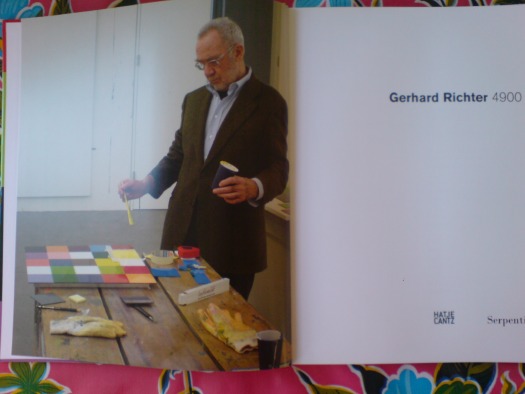
OK, now it's been bugging me a bit, this catalogue photo of Gerhard Richter with a paint brush, ostensibly going to town on the work that is the lone subject of the book, 4900 Colours, which is comprised of randomly generated color grids on 196 enamel-on-aluminum panels.
First off, I think the explanation is correct that the painting in the photo is actually a study, a prototype, a concept, a related-but-distinct work. But as the first thing a reader sees upon opening the catalogue, the photo powerfully argues--or implies--that Richter painted the work we are about to see.
Which I am relieved to know he didn't, remember? Mine is not one of those gripes about an artist painting his own paintings, a la Koons--who proudly doesn't--or Hirst--who shamelessly doesn't, except when he embarrassingly does. If any painter actually is a painter, it's Gerhard Richter, amiright?
But Richter's whole project seems based on the premise of not romanticizing the painter's gesture or the artist's subjectivity. It's why he uses photographs as subject matter. And color charts. Mechanical. In the case of 4900 Colours, it's why he outsourced the colors and placement to a randomizing computer program. [Not that he was remotely the first artist to deploy randomness or computer instructions in his work, of course.]
But wait, that's not all! Here's Benjamin Buchloh's rather torturous description of the making of 4900 Colours:
Analogously to expanding the technological order of painting's composition, Richter has also decided to dislodge the very process of manufacturing the painting from the hand to the mechanical devices of the spraygun handled by a technical collaborator. (The colour chips making up the paintings are individually spray-painted lacquer squares. Once solidified, they are inserted like elements of a mosaic into the prefixed structural arrangement. Each element consists of 25 coloured squares glued or taped onto the supporting Aludibond panel.) These decisions form the base for the permutability of the 4,900 colour chips and panels, since they were conceived from the start as a structure of permutation that could vary its own quantitative arrangements in 11 different presentational constellations.[I know, I could have stopped before that last sentence, but that'd be like leaving a birthday party just as they're bringing out the cake. Someone needs to endow an editorship at Harvard.]
Buchloch goes on to say Richter is not, like some artists [Moholy-Nagy, *cough* Judd], triumphantly declaiming "the superceding of painting's artisanal past," with his mechanicism; his is "a rather detached, not to say resigned, acceptance of the inevitable regimes of technological production."
Sigh. Then if the facture-free production of 4,900 Colours is so intrinsic to both its "monotonous polychromy" and its--I love this--"almost Beckettian complacency in the exhaustion and hopelessness that technological progress without social transformation has inflicted on the subject," why is the artist posing on with a brush as he gets ready to lay down the last stroke?
I think the explanation lies in the contradictory expectations that persist around Richter and his work. The Buchlohs among us want their Beckettian techno-anomie. The Joe Hage collector-fanboys among us want the intimacy of hanging around the studio and being present for The Moment of Creation. The gallerygoers among us want permission to just soak, guilt-free, in the beauty of a work. While the bookreaders and bloggers among us apparently just want to overanalyze a single photo in a single book on a single work.












